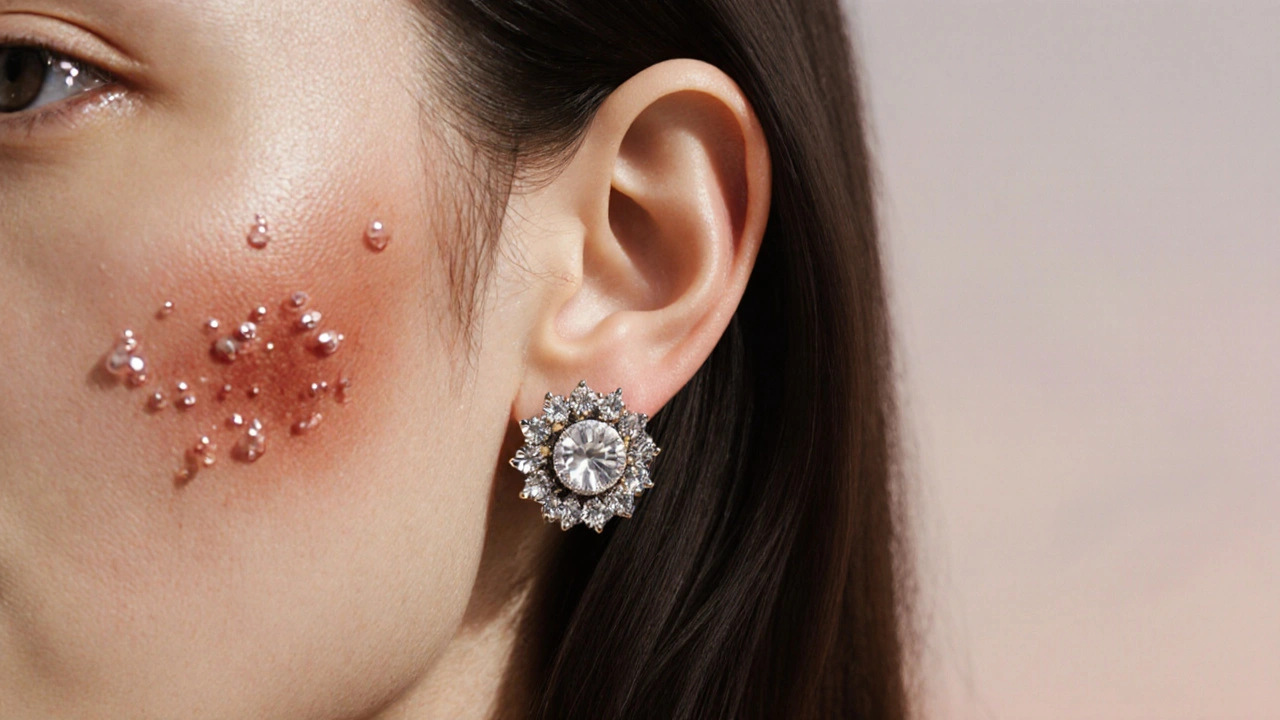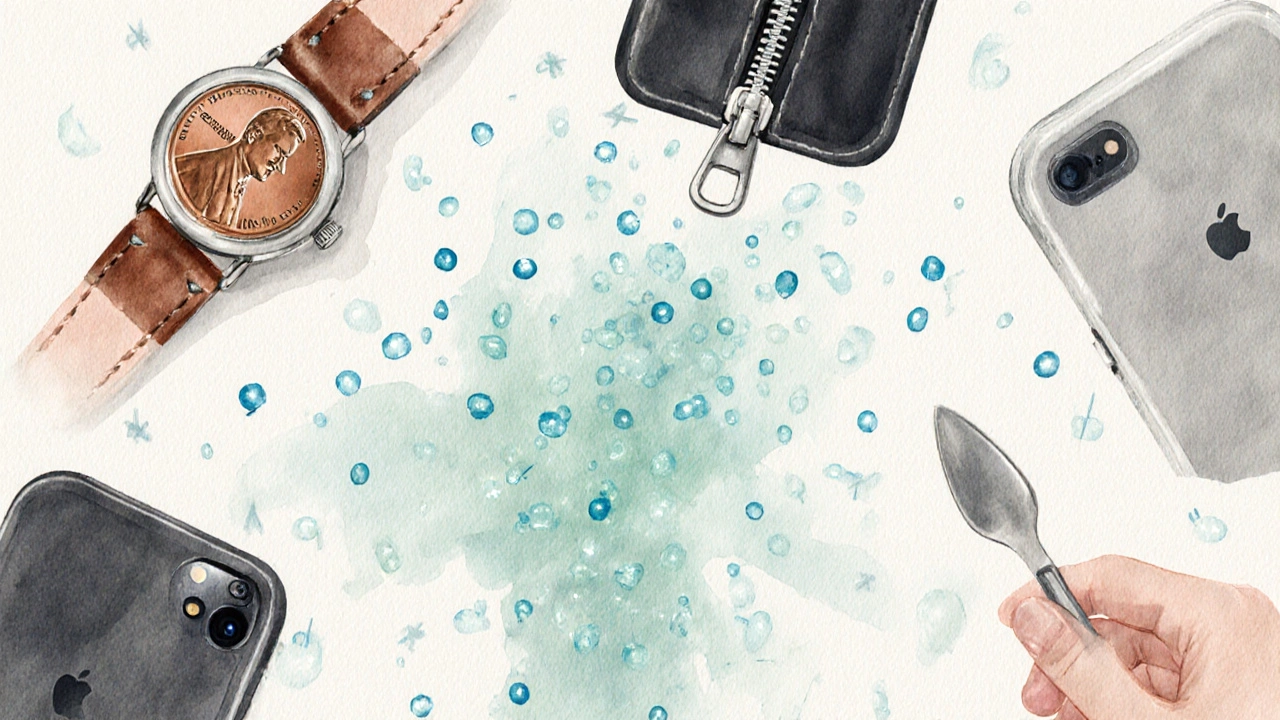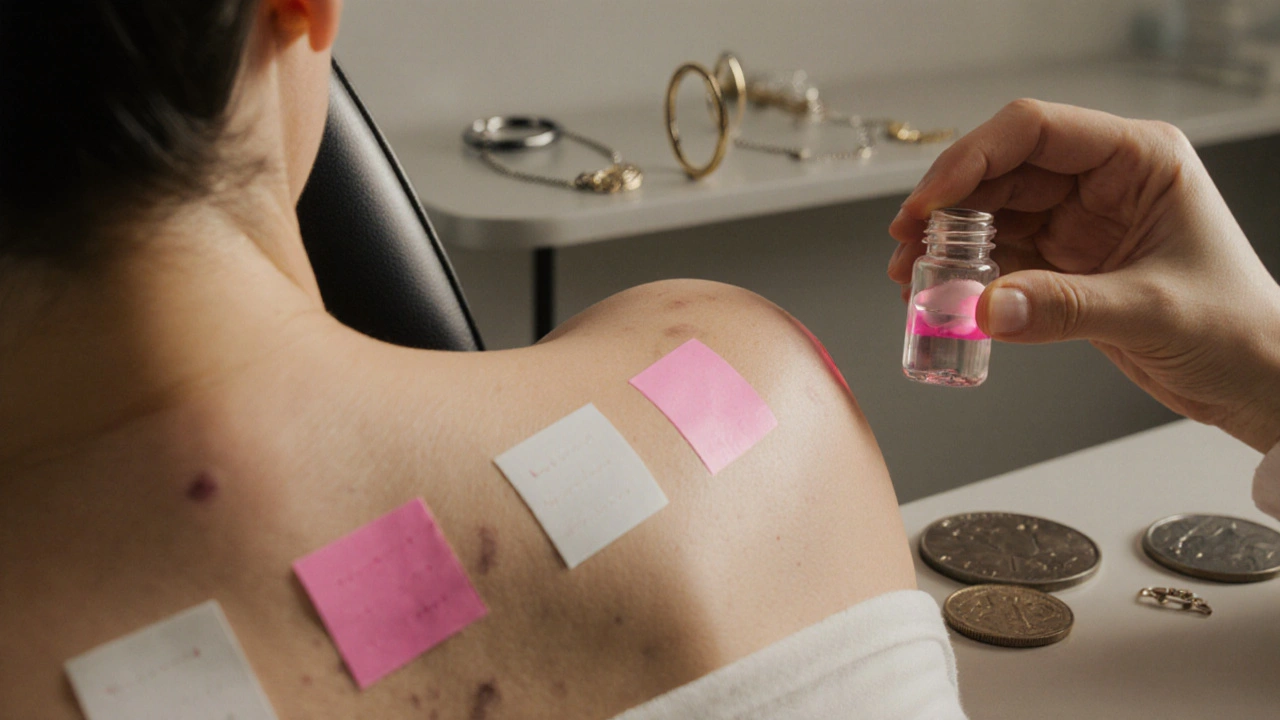
Nickel Allergy Risk Assessment Tool
Assessment Guide
Answer the following questions about your exposure habits and symptoms to get an estimate of your risk for nickel allergy.
Your risk assessment will appear here after answering the questions.
Ever wondered why a simple pair of earrings can turn your ear into a red, itchy mess? The culprit is often nickel allergy, a common trigger of contact dermatitis that many people mistake for a generic rash. This article untangles how nickel interacts with your skin, shows you where the metal hides, and gives you clear steps to diagnose and keep it under control.
What Is Nickel Allergy?
Nickel allergy is an immune‑mediated hypersensitivity to nickel ions that leach from metal objects onto the skin. When nickel contacts the epidermis, it dissolves into nickel ions that bind to skin proteins, forming a new complex that the immune system flags as foreign.
The reaction is classified as a Type IV (delayed) hypersensitivity, meaning T‑cells recognize the nickel‑protein complex and launch an inflammatory response 24‑72hours after exposure. People with a genetic predisposition or repeated low‑level exposure are most likely to become sensitized.
How Nickel Triggers Contact Dermatitis
Contact dermatitis is the umbrella term for skin inflammation caused by direct contact with a substance. In the case of nickel, the process follows a predictable path:
- Nickel ions dissolve into sweat or skin moisture.
- They bind to endogenous proteins, creating a neo‑antigen.
- Skin‑resident Langerhans cells capture the neo‑antigen and travel to nearby lymph nodes.
- Memory T‑cells become primed; on re‑exposure they release cytokines that drive redness, swelling, and itching.
This delayed reaction distinguishes allergic contact dermatitis from irritant dermatitis, which occurs instantly due to direct chemical damage.
Common Sources of Nickel Exposure
Nickel is omnipresent in everyday items. Knowing the usual suspects helps you cut down on accidental contacts:
- Jewellery - especially costume pieces, watch straps, and belt buckles.
- Coins - pennies, nickels (U.S.), and many foreign currencies.
- Metal fasteners - zippers, snaps, and eyeglass frames.
- Electronic devices - smartphone cases, laptop hinges, and headphones.
- Household items - kitchen utensils, pots, and even some paints.
In Australia, the Australian Standards AS/NZS 1695:2006 limits nickel release from products that touch the skin for more than 10minutes, but older items and imported goods may still exceed those limits.

Recognizing Nickel‑Induced Contact Dermatitis
Typical signs appear 24‑72hours after contact and include:
- Red, raised patches that may merge into larger plaques.
- Intense itching or a burning sensation.
- Small blisters or clear fluid oozing from the edges.
- Dry, scaly patches once the acute phase fades.
The rash usually mirrors the shape of the offending item - a perfect circle under a coin or a thin line along a watch band. If you notice that pattern, nickel is a strong suspect.
Diagnosis: Patch Testing and Nickel Release Test
When self‑assessment isn’t enough, a dermatologist can confirm the allergy with two reliable methods.
Patch testing involves applying small amounts of standardized allergens to the back for 48hours. After removal, the skin is examined at 48hours and again at 72-96hours. A positive reaction shows a defined red‑white papule at the nickel spot.Nickel release test (often using dimethylglyoxime) is a simple on‑site check. A swab dipped in the reagent turns pink if the metal releases more than 0.5µg/cm²/week - the threshold set by the EU Nickel Directive.
| Aspect | Patch Test | Nickel Release Test |
|---|---|---|
| Purpose | Confirm sensitisation | Detect excessive nickel emission |
| Setting | Clinic | Home or shop |
| Result time | 48‑96hrs | Immediate colour change |
| Cost (AU) | $80‑$120 | Under $10 for a kit |
Treatment and Prevention
Once nickel allergy is confirmed, the goal shifts to soothing the flare‑up and preventing future episodes.
- Topical corticosteroids - Apply a mid‑potency cream (e.g., hydrocortisone1%) twice daily for 5‑7days. For severe patches, a prescription‑strength steroid may be needed for a short course.
- Moisturise the barrier with fragrance‑free emollients to reduce transepidermal water loss.
- Identify and remove the offending item. Replace metal jewellery with hypo‑allergenic alternatives such as surgical‑steel, titanium, or pure gold (≥18carat).
- Use a protective coating. Clear nail polish or a commercial anti‑nickel sealant can temporarily block ion release on items you can’t discard.
- Consider antihistamines if itching disrupts sleep, though they don’t treat the underlying inflammation.
For chronic or widespread cases, a dermatologist may prescribe calcineurin inhibitors (e.g., tacrolimus) or recommend phototherapy.

Regulations and Standards
Regulatory bodies worldwide have set limits to curb nickel exposure:
- EU Nickel Directive (1994) - restricts release to 0.5µg/cm²/week for items in prolonged skin contact.
- Australian Standard AS/NZS 1695:2006 - mirrors the EU limit for consumer goods sold in Australia.
- U.S. Consumer Product Safety Commission - no federal nickel limit, but many states adopt the EU standard voluntarily.
Manufacturers label “nickel‑free” only when testing confirms compliance with these thresholds, so look for the certification symbol on jewellery and accessories.
Quick Checklist to Manage Nickel Allergy
- Spot the pattern: rash matches a metal object?
- Do a dimethylglyoxime test on suspect items.
- Schedule a patch test if you’re unsure.
- Swap to hypo‑allergenic metals or plastic alternatives.
- Treat acute flares with a mid‑potency steroid and moisturiser.
- Keep a diary of exposures to pinpoint hidden sources.
Frequently Asked Questions
Can I develop a nickel allergy as an adult?
Yes. While many sensitizations occur in teenage years, repeated exposure in adulthood can also trigger a new allergy. The immune system can become sensitised at any age.
Is all jewellery that contains nickel unsafe?
Not necessarily. If the item meets the 0.5µg/cm²/week release limit, it is considered safe for most nickel‑sensitive people. However, personal tolerance varies, so a patch test is the most reliable check.
Do over‑the‑counter creams cure nickel dermatitis?
OTC hydrocortisone can reduce mild inflammation, but severe or persistent rashes often need prescription‑strength steroids or alternative anti‑inflammatories prescribed by a dermatologist.
Can I test my own skin at home?
Home patch‑test kits exist, but they lack the controlled environment of a clinic and may give false‑negative results. A professional patch test remains the gold standard.
Is there a cure for nickel allergy?
Currently, the only long‑term solution is avoidance. Desensitisation therapies are under research, but none are widely approved yet.
Why do some people react to nickel while others don’t?
Genetic factors, such as certain HLA‑DR alleles, increase susceptibility. Women also tend to have higher rates, likely due to greater exposure from jewellery.
Can diet affect nickel allergy?
Dietary nickel is absorbed in tiny amounts and generally doesn’t trigger skin reactions. However, very high‑nickel foods (like nuts, cocoa, and legumes) may exacerbate symptoms in some highly sensitised individuals.


Comments
jana caylor
Nickel can really mess with your ears if you’re not careful.
Vijendra Malhotra
If you keep snapping on cheap metal jewelry without checking for nickel, you’re basically inviting a rash to set up camp on your skin. The delayed Type IV reaction can turn a simple itch into a full-blown flare that lasts days. Many people think it’s just a normal irritation, but the immune system is actually mounting a targeted attack. Cutting out high‑release items and swapping to surgical‑steel or titanium will save you a lot of discomfort.
Nilesh Barandwal
Nickel’s silent sabotage is real!!! Avoid the culprits or brace for the burn!!!
Elise Smit
A practical first step is to test your favorite pieces with a dimethylglyoxime kit; a pink hue means the metal is releasing too much nickel. Replace the offending items with hypo‑allergenic alternatives, and keep a simple skin diary to spot hidden sources. Moisturising regularly also reinforces the barrier, making any accidental exposure less painful.
Sen Đá
Regulatory compliance cannot be an afterthought; manufacturers must adhere to the EU Nickel Directive limit of 0.5 µg/cm²/week for any product that maintains prolonged skin contact. Failure to meet this standard not only endangers consumers but also breaches legal obligations under AS/NZS 1695:2006 in Australia. Consumers should demand proper certification before purchase, and retailers must enforce strict inventory checks.
LEE DM
Indeed, the burden falls on both producers and buyers; asking for the certification label is a quick way to verify compliance without getting tangled in technical jargon.
Olivia Crowe
Good news: once you eliminate the nickel triggers, most rashes clear up in a week with a modest steroid cream and consistent moisturising. Keep an eye on new accessories, and you’ll stay ahead of the itch!
Benton Myers
Observations show that people who wear coins daily often develop a faint line of irritation around the fingertips after a few months.
Pat Mills
While the coin‑related line might seem harmless at first glance, it actually signals that nickel ions are actively penetrating the epidermis. Over time, repeated exposure can sensitize the immune system, escalating a simple redness into a chronic dermatitis. That’s why a quick dip in a dimethylglyoxime solution can save you weeks of uncomfortable flare‑ups. Moreover, swapping to nickel‑free tokens or using a protective coating dramatically reduces the ion release. Dermatologists often recommend a mid‑potency steroid for the acute phase, followed by a fragrance‑free emollient to rebuild the skin barrier. If the rash persists beyond a week, a patch test is the gold standard for confirming nickel hypersensitivity. Remember, avoidance is the most effective long‑term strategy; once sensitized, the body remembers the culprit. Lastly, you don’t need to abandon all metal accessories-surgical‑steel and titanium are excellent low‑release alternatives.
neethu Sreenivas
🧐 The human body is an intricate tapestry of immune vigilance, and nickel is a surprisingly adept provocateur. When that shiny buckle or inexpensive earring releases ions, we’re not just dealing with a superficial nuisance; we’re confronting a T‑cell mediated siege that can linger for days. 🎯 The delayed nature of Type IV hypersensitivity means the itching and redness can appear well after the initial contact, often catching us off‑guard. 📅 Many sufferers keep a mental log of exposures, yet the hidden sources-like metal fasteners on shoes or even certain dietary supplements-can slip through unnoticed. 🔍 A disciplined approach starts with a simple dimethylglyoxime test; the pink hue is a neon sign that the metal is exceeding the 0.5 µg/cm²/week threshold set by the EU Directive. 🌍 If the test is positive, the next step is substitution: surgical‑steel, titanium, or pure gold (≥18 carat) become the allies in your skin‑care arsenal. 🛡️ Meanwhile, during an active flare, a mid‑potency corticosteroid cream applied twice daily for five to seven days can quell the inflammatory cascade, but it’s crucial not to over‑use steroids to avoid skin thinning. 💧 Complement the regimen with a fragrance‑free moisturizer to restore the lipid barrier, which acts like a moat defending the castle of your epidermis. 📔 Keeping a detailed exposure diary-note the date, the item, and the severity of the reaction-provides valuable data for your dermatologist, who may recommend a formal patch test to confirm the nickel sensitization. 🩺 Patch testing remains the clinical gold standard: small doses of standardized allergens are applied under occlusion, observed at 48‑ and 72‑hour intervals, and scored for reaction intensity. 📈 If you’re diagnosed, the long‑term management plan emphasizes avoidance, but there’s ongoing research into desensitisation therapies, which could one day offer a functional cure. 🌱 Until then, the mantra is simple: identify, replace, treat, and document. 🎉 By staying vigilant and proactive, you can keep nickel‑induced dermatitis at bay and enjoy your accessories without the constant dread of a rash.
Keli Richards
Staying aware of nickel sources helps you dodge most flare‑ups. A quick test and a few smart swaps go a long way.
Ravikumar Padala
Honestly, the whole nickel‑avoidance spiel feels a bit overblown unless you’ve actually suffered an allergic breakout. The guidelines are solid, but many people wear cheap jewelry without ever seeing a rash, so the panic can be unnecessary. Still, if you notice that stubborn line on your wrist after a week of a new bracelet, it might be worth a quick test. It’s not about fearing every metal, just being sensible about what stays in constant contact with your skin.